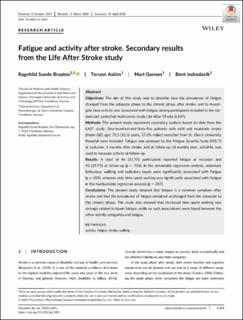| dc.contributor.author | Braaten, Ragnhild Sunde | |
| dc.contributor.author | Askim, Torunn | |
| dc.contributor.author | Gunnes, Mari | |
| dc.contributor.author | Indredavik, Bent | |
| dc.date.accessioned | 2020-09-29T07:03:44Z | |
| dc.date.available | 2020-09-29T07:03:44Z | |
| dc.date.created | 2020-09-22T14:41:26Z | |
| dc.date.issued | 2020 | |
| dc.identifier.citation | Physiotherapy Research International. 2020, 1-8. | en_US |
| dc.identifier.issn | 1358-2267 | |
| dc.identifier.uri | https://hdl.handle.net/11250/2680099 | |
| dc.description.abstract | Objectives
The aim of this study was to describe how the prevalence of fatigue changed from the subacute phase to the chronic phase after stroke, and to investigate how activity was associated with fatigue among participants included in the randomized controlled multicentre‐study Life After STroke (LAST).
Methods
The present study represents secondary analysis based on data from the LAST study. One‐hundred‐and‐forty‐five patients with mild and moderate stroke (mean (SD) age: 71.5 (10.5) years, 57.2% males) recruited from St. Olav's University Hospital were included. Fatigue was assessed by the Fatigue Severity Scale (FSS‐7) at inclusion, 3 months after stroke, and at follow‐up 18 months later. activPAL was used to measure activity at follow‐up.
Results
A total of 46 (31.7%) participants reported fatigue at inclusion and 43 (29.7%) at follow‐up (p = .736). In the univariable regression analysis, sedentary behaviour, walking and sedentary bouts were significantly associated with fatigue (p ≤ .015), whereas only time spent walking was significantly associated with fatigue in the multivariable regression analysis (p = .017).
Conclusions
The present study showed that fatigue is a common symptom after stroke and that the prevalence of fatigue remained unchanged from the subacute to the chronic phase. The study also showed that increased time spent walking was strongly related to lower fatigue, while no such associations were found between the other activity categories and fatigue. | en_US |
| dc.language.iso | eng | en_US |
| dc.publisher | Wiley | en_US |
| dc.rights | Attribution-NonCommercial-NoDerivatives 4.0 Internasjonal | * |
| dc.rights.uri | http://creativecommons.org/licenses/by-nc-nd/4.0/deed.no | * |
| dc.title | Fatigue and activity after stroke. Secondary results from the Life After stroke study | en_US |
| dc.type | Journal article | en_US |
| dc.type | Peer reviewed | en_US |
| dc.description.version | publishedVersion | en_US |
| dc.source.pagenumber | 1-8 | en_US |
| dc.source.journal | Physiotherapy Research International | en_US |
| dc.identifier.doi | 10.1002/pri.1851 | |
| dc.identifier.cristin | 1832173 | |
| dc.description.localcode | © 2020 The Authors. Physiotherapy Research International published by John Wiley & Sons Ltd This is an open access article under the terms of the Creative Commons Attribution‐NonCommercial‐NoDerivs License, which permits use and distribution in any medium, provided the original work is properly cited, the use is non‐commercial and no modifications or adaptations are made. | en_US |
| cristin.ispublished | true | |
| cristin.fulltext | original | |
| cristin.qualitycode | 2 | |

